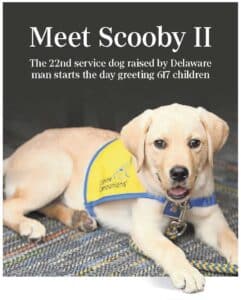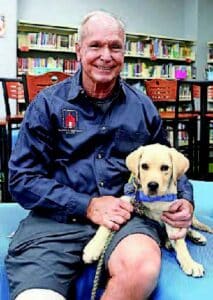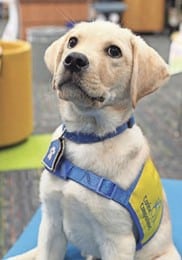 Scooby II is a 3-month-old golden retriever-Labrador mix being raised for Canine Companions by Mike Hartsky
Scooby II is a 3-month-old golden retriever-Labrador mix being raised for Canine Companions by Mike Hartsky
North Star, MD
By Krys’tal Griffin/Delaware News Journal – May 30, 2023 – Photos by Damian Giletto/Delaware News Journal
Gasps of ‘Look, a puppy!’ and whispers of “There’s a dog!” float through a group of bright-eyed children as they walk into the colorful library at North Star Elementary School in North Star. Amidst the stacked shelves of library books and brightly colored knick-knacks, the target of all their attention belongs to Scooby II, a 3-month-old golden retriever-Labrador mix and resident service dog stationed at the school with his handler, 68-year-old Mike Hartsky. On a typical weekday, you can find Hartsky and Scooby II greeting 617 students at the front door, coaxing shy children from cars during parent drop-off and mingling with students in the hallways.
“With a name like Scooby in an elementary school, you can imagine the takeoff,” Hartsky joked. “I have to move him somewhere fast because they want to keep him and pet him. I say, “One pet and keep going.”

Mike Hartsky, who works at North Star Elementary School, is raising his 22nd service dog for Canine Companions.
These elementary schoolers might see Scooby II as their teacher in many ways – showing them how to be social and unafraid to leave their parents for the day, teaching them about disabilities – but little do they know, Scooby II will learn plenty from them, too.
To Scooby II, walking the halls of North Star is a fun social adventure every day, filled with fun interactions and new places to sniff. To Hartsky, his day-to-day care and socialization of Scooby II is only his latest endeavor as a puppy raiser with Canine Companions, a role he as served over the past 23 years for 22 dogs.
“Raising puppies , I’ve done this all my life, and it’s something that I really enjoy and will continue doing as long as possible,” Hartsky said. “Raising for Canine Companions is something special.”
Hartsky will care for and teach Scooby II until is 1 and a half years old when the dog transitions to program facilities for six months of training before being placed with a person in need at no cost.
While not every trained puppy passes the final certification – some are removed due to medical, physical, emotional or other issues and get placed for adoption – Handlers provide early guidance to give each dog the best chance possible. Hartsky’s success rate is 95%, he said.
Enhancing people’s lives and independence
Hartsky and Scooby II are just one pair out of the 1,181 puppies currently being raised and trained across the country, 180 of which are in the Northeast Region. The region typically places 60 to 70 service dogs with individuals in need per year, according to Ellen Torop, program director of Canine Companions.
Canine Companions works with 2,600 active puppy/raiser teams throughout the country and has placed more than 7,100 service pups since the organization was founded in 1975.

To Scooby II, walking the halls of North Star is a fun social adventure every day, filled with fun interactions.
The mission of Canine Companions is to enhance people’s lives and independence by placing them with specially trained dogs who allow them to confidently live on their own terms, Torop said.
The jobs of a dog vary depending on the needs of its owner, but many pups are taught commands like picking items up, turning lights on and off, helping with alarms and opening doors. Some puppies will serve physical therapy needs, be placed with children or help out in health care settings.
“For the average person who lives with dogs, most of us know how difficult raising a puppy is,” Torop said. “Puppy raisers get this little 8-week-old puppy and it’s a blank slate.”
Due to the strict criteria of service dogs, the organization has an in-house breeding program to help them prepare puppies for what’s in store, manage temperament and ensure handlers have ample time with each dog for socialization, skill-building and basic training.
Torop, who has been with Canine Companions for 34 years, cites the intense amount of support and compassion present from puppy raisers.
“They’re spending so much time and money on these dogs just to send them off to someone else. You have to fall in love with the dogs to be successful,” she said. “People like Mike, they’re the reason this program continues.”
This is really not about me
For someone who as stuck with service dog training for as long as Hartsky has – and during a countless number of poop bags, he joked, it might be surprising to hear he initially didn’t want to be in this role.
Working for Electronic Data Systems in the 1980’s, Hartsky saw an internal bulletin about a puppy-raising program in Texas and looked into it knowing he had an extensive background from raising many of his own pets.
“I looked at it and I said, ‘Well, wait a minute. You mean I have to give away these dogs after I do all this work?'” Hartsky recalled. “And then about 20 seconds later, it hit me. I thought to myself , “Well, I’m looking at it from the wrong perspective. This is really not about me, is it?”
Hartsky was immediately on board with his first service puppy, Rainier, he said. Hartsky quickly learned how impactful the work is for an unexpected demographic: the hundreds of children he meets while training each puppy.
Hartsky uses simple commands for pups, like”sit,” “down” and “roll”, to teach first graders about single-syllable words when he visits classrooms to talk about his work.
Oftentimes, they seek him out and ask when he and his dog can visit next. Teachers can’t wait for their daily dose of Scooby II either.
“Everybody loves it. I mean, look at this dog. How can you not love this dog by looking at him?” Hartsky said as he pets Scooby II, calling him a “good boy.”
After a visit to an elementary school classroom, Hartsky and Scooby II were flooded with letters from the students.
“I learned that we help make Scooby ready to be a service dog. I think it was really fun seeing and learning about Scooby and how he can help people. I hope you come again,” a letter said.
“I really hope you come to our classroom more because I had so much fun. Scooby did so good and I think he is very cute and fluffy,” complimented another student.
And for Hartsky, it’s the pups like Scooby II and the individuals they are placed with that stick with him.
It’s a wonderful thing
When a dog successfully makes it through the final six months of intensive training, handlers are invited to a graduation ceremony where the service dogs are officially placed with their assignments. Individuals who raised the puppies get to transfer the leash of their former partner directly into the hands of the dog’s new partner.
This is the last puppy raisers will see of the dog unless their new families want to stay in touch, and Hartsky has been lucky enough to have several of his long-term graduates keep in touch over the years. Some send him baked goods or reach out periodically to let him know they appreciated his role in the process, he said.
One of his notable moments as a puppy raiser belongs to a dog named Levin that was under his care years ago before being placed with a skilled companion team, where both parents and a child manage a dog at the same time.
Levin was with the family for about seven years, and the team made sure to keep a close bond with Hartsky, often seeing him at local fundraising events and disability seminars.
“They would call me every year and say, ‘You coming to this one?’ So that type of thing was nice.” Hartsky said. “It was really, really good’cause you see how the dog has bonded wiht the individual and the results of your work.”
Hartsky will spend the next year working with Scooby II before sending to his next home.
“It breaks my heart every time. But the beauty of this program is, I got another one coming,” he said. “I could talk about this program and get tears in my eyes because it’s so close to my heart. It’s a wonderful thing that I’m continued to be allowed to do it.”

